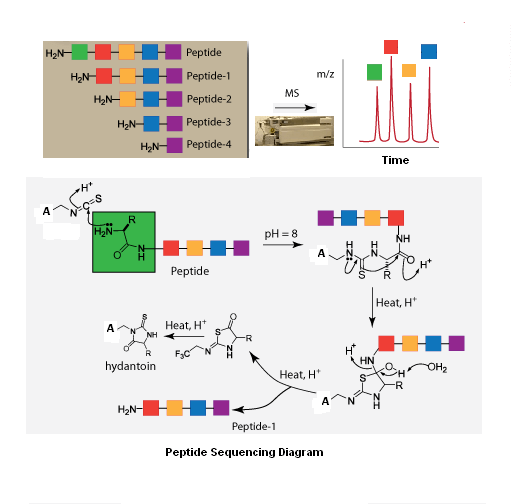N-terminal Sequence Analysis
Edman degradation is a method first established by Pehr Edman for analyzing the N-terminal amino acid sequence in peptide chains or proteins. The principle of Edman degradation is very simple. It involves a reaction under alkaline conditions where phenylisothiocyanate (PITC) reacts with the protein (polypeptide) to be tested to form a phenylthiocarbamoyl (PTC) derivative at the N-terminal amino group. This is followed by cyclization and selective cleavage of the peptide chain at the N-terminal to obtain a thiazolinone phenylamine derivative of the N-terminal amino acid residue. The derivative is then extracted using an organic solvent, and under acidic conditions, the unstable derivative is transformed into a stable phenylthiohydantoin (PTH) derivative, leaving the peptide chain's amide bonds unaffected. By analyzing the resulting PTH-amino acid with HPLC or electrophoresis, the type of amino acid can be identified. Repeating the amino acid identification reaction allows for sequential analysis of the amino acid sequence from the N-terminal to the C-terminal. For longer protein (polypeptide) sequences, the sample can be first cut into smaller peptide segments, analyzed for peptide segment sequences, and then the peptide segment information can be pieced together to obtain the complete protein sequence information.

Protein N-terminal sequencing process
Advantages of Edman degradation for N-terminal sequencing:
1. The reaction yield and recovery rate of PITC with all amino acid residues are high, resulting in few by-products that can be accurately identified by chromatography;
2. The reaction time is fast, requiring only 30 minutes for coupling time and 5 minutes for cleavage reaction time for most amino acid residues;
3. The peptide chain remains intact after the reaction, allowing for repeated determination of the new N-terminal amino acid using Edman degradation.
Issues to note when using Edman degradation for N-terminal sequencing:
1. Sample purity should be >90%, salt ion content should be within 50 mmol/L, should not contain denaturants like SDS, and the N-terminal must be a homogeneous high-purity sample;
2. 10 Pmol samples can determine 20 amino acids;
3. Liquid samples should not contain proteases, and testing is recommended as soon as possible to prevent degradation over time;
4. Membrane-transferred samples should not be left for too long before transfer to prevent sample diffusion. After transfer, they can be sealed and stored for 3-6 months. It is recommended to use Coomassie R-250 for staining, and CAPS buffer is recommended for electrophoresis buffer;
5. If there is no signal peak for the sample, it is recommended to perform N-terminal blocking on the protein;
6. It is recommended to use high-purity buffers throughout the reaction process as much as possible.
Case study:
Bio-Tech uses the PPSQ series instruments launched by Shimadzu to analyze the N-terminal amino acid sequence of protein or polypeptide samples, capable of analyzing more than 30 N-terminal amino acids. Below is the actual chromatographic result of our analysis of a certain protein drug. The project analyzed the first 15 amino acids of the protein drug in the sample. As can be seen from the chromatogram of the 15th amino acid, the chromatographic peak value is still very high, allowing for very accurate results.














Bilingual project report in Chinese/English
In the technical report, Bio-Tech will provide you with a detailed bilingual technical report in Chinese and English, including:
1. Experimental steps (Chinese and English)
2. Relevant mass spectrometry parameters (Chinese and English)
3. Mass spectrometry images
4. Raw data
5. N-terminal sequence information of biopharmaceuticals
One-stop service for N-terminal sequence determination of biopharmaceuticals
You only need to place an order and send the sample
Bio-Tech one-stop service completes: sample processing - on-machine analysis - data analysis - project report
Related services
N/C-terminal sequence analysis
Mass spectrometry N-terminal sequence analysis
Edman degradation N-terminal sequence analysis
Protein N-terminal sequence analysis based on Edman degradation
How to order?





